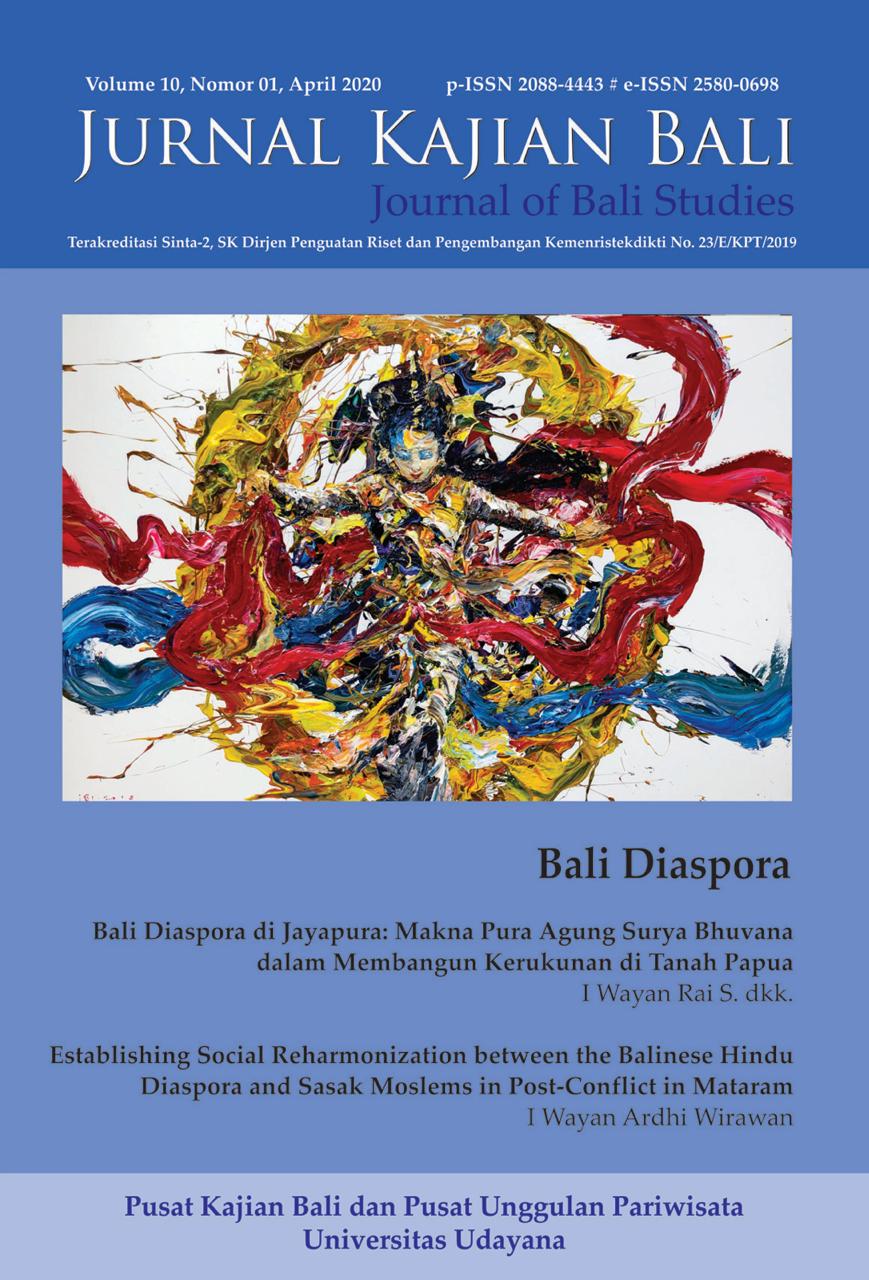Respon terhadap Otentisitas: Tanggapan Wisatawan Asing terhadap Unsur-unsur Budaya dalam Tiga Hotel Internasional di Bali
Abstract
This article examines how foreign tourists respond to authentic elements of Balinese culture displayed by hoteliers in Bali. It takes three international hotels as the object of study, namely the Nusa Dua Beach Resort and Spa Hotel, W Hotel Seminyak, and Four Seasons Resort in Ubud. These three hotels were chosen because they are international hotels located in three different tourist destinations, but all offer elements of Balinese culture as part of their services. The article discusses the problem of how tourists respond to elements of Balinese culture, especially architecture, food, art-culture and hospitality. This is qualitative research that draws on data collected through the technique of netnography in the form of tourist comments posted on Tripadvisor about services in the hotel where they stayed. Data were analyzed with response theory and interpretive content analysis theory. Analysis shows that tourists are attracted to authentic elements of Balinese culture. The article recommends that international hotels explicitly display elements of Balinese culture to support the image of Bali as a cultural tourism destination.
Keywords: Balinese culture, architecture, Balinese food, netnography, hospitality
Downloads
References
Davison, Julian. (2003). Balinese Architecture. Singapore: Tuttle Publishing.
DestinAsian. (2014). “Fokus Baru Four Seasons Sayan”, https://destinasian.co.id/fokus-baru-four-seasons-sayan/ Accessed 20 Februari March 2020.
Drisko, James W. and Tina Maschi. (2016). Content Analysis. New York: Oxford
Eagleton. 2005 [1983]. Literary Theory: An Introduction. UK: Basil Blackwell.
Engeset, Marit Gundersen and Ingunn Elvekrok. (2014). “Authentic Concepts: Effects on Tourist Satisfaction”, Journal of Travel Research, pp.1–11. DOI: 10.1177/0047287514522876
Fiske, John. 1982. Introduction to Communication Studies. London: Routledge.
Fowler, Michael. (2019). “TripAdvisor fake reviews: Report reveals 1.4 million fake reviews submitted”, Stuff, https://www.stuff.co.nz/travel/travel-troubles/115911867/tripadvisor-fake-reviews-report-reveals-14-million-fake-reviews-submitted Akses 20 Februari 2020.
Jauss, Hans Robert. (1982). Toward an aesthetic of reception. Minneapolis: University of Minnesota Press.
Kanca, I Nyoman dan I Nengah Wijaya. 2015. “Persepsi Wisatawan Mancanegara terhadap Kualitas Pelayanan Kantor Depan di Nusa Dua Beach Hotel & Spa Bali”, Soshum Jurnal Sosial dan Humaniora, Vol. 5, No.1, Maret, pp. 12-21.
Kayam, Umar. (1981). Seni, Tradisi, Masyarakat. Jakarta: Sinar Harapan.
Kozinets, V. Kozinets. (2010) Netnography: Doing Ethnographic Research Online. London: Sage Publications.
MacRae, Graeme. (1992). ‘Tourism and Balinese culture’. MA thesis, University of Auckland.
McQuail, Denis. 1996. Mass Communication Theory. London: Saga Publication.
Mkono, (2013). “Hot and Cool Authentication: A Netnographic Illustration”, Annals of Tourism Research, Vol. 41, pp. 215–218.
Mkono, M. 2011. “The othering of food in touristic entertainment: A netnography”, Tourist Studies, 11(3), 253–270.
Mkono, M. (2012a). “Authenticity does matter”, Annals of Tourism Research, 39(1), 480–483.
Mkono, M. (2012b). “A netnographic examination of constructive authenticity in Victoria Falls tourist (restaurant) experiences”, International Journal of Hospitality Management, 31(2), 387–394.
Perda Provinsi Bali No 2/2012 tentang Kepariwisataan Budaya.
Picard, Michel. (1996). Bali: Cultural tourism and touristic culture. Singapore: Archipelago Press.
Press Release. (2011). “W Hotels Worldwiode Brings Bold New Dimension of Design to Bali with Debut of W Retreat & Spa Bali – Seminyak”. Seven pages.
Putra, I Nyoman Darma. (2008). Bali dalam Kuasa Politik. Denpasar: Buku Arti.
Putra, I Nyoman Darma dan Sioban Campbell (eds) (2015). Recent developments in Bali tourism: culture, heritage, and landscape in an open fortress.Denpasar: Prasasti.
Putra, I Nyoman Darma. (2019). “One Hundred Years of Cultural Tourism in Bali: An Insider’s Perspective”, paper presented at International Academy for the Study of Tourims Bienall Conference 2019, STP Nusa Dua, Bali.
Sari, Nila Khrisna Puspita. (2014) “Pengaruh Store Atmosphere terhadap Store Image Potato Head Beach Club Seminyak – Bali”, CALYPTRA, Vol 3, No 2, pp.1-12.
Selden, Raman. (1985). A Reader's Guide to Contemporary Literary Theory. Kentucky: University Press of Kentucky.
Tripadvisor. (2019). https://www.tripadvisor.com.au/TripAdvisorInsights/w5144 Akses 20 Februari 2020.
Verheijen, Bart & I Nyoman Darma Putra. (2019). “Balinese cultural identity and global tourism: the Garuda Wisnu Kencana Cultural Park”, Asian Ethnicity, DOI: 10.1080/14631369.2019.1641691
Vickers, Adrian. (2012) [1989]. Bali A Paradise Created. Singapore: Tuttle Publishing.
Vickers, Adrian. (2015). “Bali Membangun kembali Industri Pariwisata: 1950-an”, Jurnal Kajian Bali (Journal of Bali Studies), Vol. 3, No. 2, October. 2015, pp. 1-38.
Wang, N. (1999). “Rethinking Authenticity in Tourism Experience”, Annals ofTourism Research, Volume 26, No. 2. Pp. 349-370.
Wiranatha, AAP Suryawan. (2019). “is Bali Still Beloved by Tourist?” , paper presented at The 3rd Bali International Tourism Conference Tourism & Hospitality Management “Toward New Paradigm of 4.0 Tourism Industry” BALI, 26-27 September 2019.
Yamashita, Shinji. (2012). “Gema Perdamaian: Tourism, Religion and Peace in Multicultural Bali”, Jurnal Kajian Bali (Journal of Bali Studies), Vol. 2, No. 2, Oct. 2012, pp. 165-181.
Yamashita, Shinji. (2013). “The Balinese Subak as World Cultural Heritage: In the Context of Tourism”, Jurnal Kajian Bali (Journal of Bali Studies), Vol. 3, No. 2, Oct. 2013, pp. 39-68.

This work is licensed under a Creative Commons Attribution 4.0 International License.



















